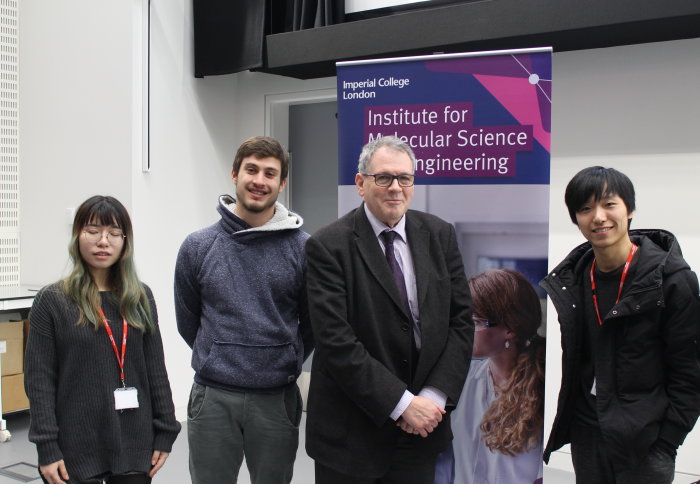A first for IMSE: novel chemical sensors in White City

Professor Paul Raithby with students from the Molecular Science and Engineering MRes course.
IMSE's first Highlight Seminar in White City demonstrated the use of novel chemical sensors with applications from jet engines to healthcare.
In the first Highlight Seminar of 2019, and the first at Imperial's White City campus, Professor Paul Raithby (University of Bath) discussed how sensing functional materials are now being adapted for use as sensors for volatile-organic compounds (VOCs); organic chemicals that easily vaporise into the atmosphere at ordinary room temperature.
Selective, robust and cost-effective chemical sensors for detecting VOCs have widespread applications in industry, healthcare and environmental monitoring. Professor Paul Raithby University of Bath
In his seminar, Prof. Raithby demonstrated the use of coatings that change colour once exposed to various VOCs. As shown in a video (below), under a control environment without VOCs present, the coating appeared yellow. However in the presence of parts-per-thousand levels of atmospheric water vapour, the coating changed to red on sub-second timescales and changed back to yellow once the water vapour was removed. Exposure to methanol induced a similar rapid and reversible colour change to blue.
The change in colour is due to a changing crystal structure that means that the sensing material changes colour depending on the particular VOC present.
The above video shows an example of a rapidly a chemical sensor that can rapidly change and is reversible.
These smart sensors are able to change colour over 10,000 cycles without any signs of degradation. Applications include, amongst others, jet engines as a jet engine's performance is highly sensitive to the amount of water entering the engine, and its accurate measurement at different altitudes is of high importance. Prof. Raithby finally showed that a camera could pick up the differences in colour, hence estimating a concentration of water vapour in the jet engine. This could be a useful tool in optimising jet engine performance.
 Professor Raithby also took time out to speak to students from the MRes in Molecular Science and Engineering, who asked about his career path along with tips for a future in academia. If you are interested in the MRes course, applications for the 2019 intake of MRes students are now open. More information can be found here, including information on how to apply.
Professor Raithby also took time out to speak to students from the MRes in Molecular Science and Engineering, who asked about his career path along with tips for a future in academia. If you are interested in the MRes course, applications for the 2019 intake of MRes students are now open. More information can be found here, including information on how to apply.
Tour of the Molecular Sciences Research Hub
Attendees to the seminar were also treated to a tour of the Molecular Sciences Research Hub (MSRH) and the Centre for Rapid Online Analysis of Reactions (ROAR) in Imperial's White City campus. The MSRH is the new research home for the Department of Chemistry and brings together nearly 800 scientists, clinicians, engineers and business partners in collaborative scientific working. New prototyping facilities and business incubator spaces encourage entrepreneurial thinking and help to turn scientific discoveries into commercial products and services.
Article text (excluding photos or graphics) © Imperial College London.
Photos and graphics subject to third party copyright used with permission or © Imperial College London.
Reporter
Dr Kieran Brophy
Faculty of Engineering
